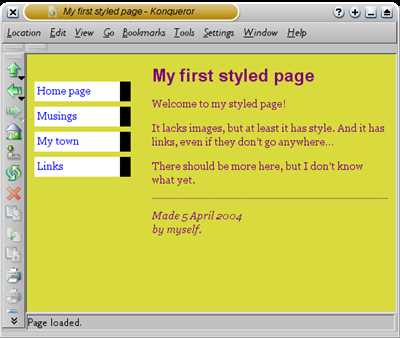
If you want to create a stylish and visually appealing website, you need to learn CSS. CSS stands for Cascading Style Sheets and it is a language used to describe the look and formatting of a document written in HTML. By adding CSS to your HTML code, you can control the colors, fonts, layout, and other visual aspects of your web page. In this article, we will give you a step-by-step guide on how to start a CSS page.
The first thing you need to do is create a new HTML file. You can do this by opening a text editor, such as Notepad or Sublime Text, and saving the file with a .html extension. Then, you need to add the doctype declaration at the beginning of your HTML file. The doctype declaration tells the browser what version of HTML you are using. For example, for HTML5, the doctype declaration looks like this:
Once you have set up your HTML file, you can start creating your CSS stylesheet. A CSS stylesheet is a separate file that contains all the style rules for your web page. It is usually saved with a .css extension. You can create a new CSS file by opening a text editor, entering the necessary CSS code, and saving the file with a .css extension.
In your CSS stylesheet, you can define various style rules using selectors. Selectors are used to select the HTML elements that you want to style. For example, if you want to style all the a elements on your web page, you can use the following selector:
a {
color: red;
}
This will change the color of all the links on your web page to red. You can also use other types of selectors, such as class selectors, ID selectors, and attribute selectors, to target specific elements on your web page.
One important thing to note is that CSS rules are applied in a cascading manner. This means that if you have multiple style rules that apply to the same element, the rule with the highest specificity will be applied. For example, if you have an inline style rule, it will override any style rules defined in external CSS files.
In addition to basic CSS, you can also use advanced CSS preprocessors, such as SASS, to make your CSS coding more efficient and organized. CSS preprocessors allow you to use variables, mixins, and other powerful features that are not available in regular CSS. They also provide a way to organize your CSS code into smaller, reusable parts, making it easier to maintain and update your stylesheets.
Once you have created your CSS stylesheet, you need to link it to your HTML file. You can do this by adding the following code in the head section of your HTML file:
Make sure to replace styles.css with the path to your actual CSS file. This will tell the browser to load and apply the styles defined in your CSS file to your HTML document.
Finally, don’t forget to add the meta tag with the viewport attribute to make your web page responsive. The viewport meta tag tells the browser how to scale and display the web page on different devices. Here is an example of how to add the viewport meta tag to your HTML file:
With these steps, you are now ready to start creating your CSS page. Remember to experiment, play around with different styles, and learn from reliable sources to improve your CSS skills. Happy coding!
- Style Sheets
- Inline-Style
- Test Headline
- Important globals
- HTML5 doctype
- Responsive meta tag
- Box-sizing
- Reboot
- Adding a style sheet
- Selectors
- elements on the page.
- elements to red by adding the following rule to your stylesheet: h1 { color: red; } It's important to note that the order in which selectors are written can affect which styles are applied. CSS applies styles based on specificity and the cascade. If two selectors target the same element with conflicting styles, the one with higher specificity or the one that appears later in the stylesheet will take precedence. You can also use the !important keyword to override other styles, but it should be used sparingly. When working with CSS, it's essential to understand how selectors work and how to use them effectively. They are the building blocks for applying styles to different parts of your HTML document, making it responsive and visually appealing. So make sure to familiarize yourself with the different selectors and their syntax to create beautifully styled web pages. Rules When starting a CSS page, there are certain rules you need to follow in order to create a well-structured and visually appealing design. Here are some important rules you should keep in mind: Globals: At the beginning of your CSS file, you should define any global styles that will be applied to multiple elements. This includes things like setting a default font family or font size. First: The first line of your CSS file should always be the @charset rule, which specifies the character encoding for the CSS file. Style: The

